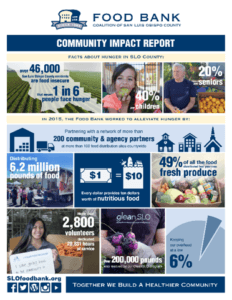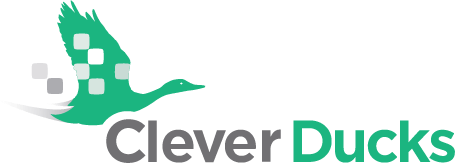By: Peter Kardel
Introduction:
Non-profits bleed or thrive over the same issues that for-profit businesses do, they just have less room for error. Small headwinds can have a big impact on their mission. This is worrisome since they provide such vital community services, often to the most vulnerable populations. Their people are what’s most important and are what cost them the most. It is vexing that many non-profits are relegated to using IT systems that fail to support them; at the same time they are the most sensitive to the impacts of IT that is more of a pest than a help.
We knew that The Food Bank Coalition of San Luis Obispo County was a highly focused, smooth running, disciplined machine. Their mission was centered at the heart of human need and they were growing. Like many successful businesses, their various systems and processes had been growing and evolving with them. The Food Bank had outgrown their IT and they could feel it. They needed their existing team to be able to deliver on into the future and keep up with surging demand. Adding staff would swell their amazingly low overhead. They needed to give their people more leverage with the right technology.
Every so often on that exciting path of progress, something breaks. A way of doing things that worked great when you had just 2 people in the department is just getting ugly when you’ve grown to 10. Or as you’ve expanded to keep more plates spinning, you reach a point where adding more sticks isn’t going to work anymore. This is not something to be frustrated with! This is natural and a good problem to have. The key is to recognize when it is time to redesign the system before it has sopped up too many resources and burned too much of your people’s time. Shepherding the growth of your business through the levels of operational maturity can be like raising teenagers: sometimes it is fast and smooth and sometimes it can require a do-over.
Background:
We first met with the leadership team to get a picture of what was important to the organization, what their strategy was, what their recent history was and where they wanted to go. We were smitten by their passion to serve people. A lot of people. Over the previous year they’d distributed 6.2 million pounds of food; somehow they had multiplied every dollar spent into $10 of nutrition. Just 6% of their total budget was overhead. This organization was thriving, not struggling. Hard demographic trends point to sustained, rapid growth of need in the communities they serve. They were going to need to continue to grow and expand their life-sustaining mission, yet keep their costs growing at a shallower rate while holding their overhead flat. They shared a number of creative plans to do just that . . . and how IT would play a role.
They knew investments in their IT needed to be made, but their current support team was stuck in a chaotic reaction-mode support cycle. During discovery interviews with key staff we  learned issues were recurring, met with slow response and had incomplete resolution. Staff was frustrated. Too much time and energy was wasted by data access interruptions, system glitches, poor network and application performance, inconsistent implementation of technology and recurring connectivity issues between sites. We could clearly see the untapped staff capacity. They just needed to be freed up to do their best work.
learned issues were recurring, met with slow response and had incomplete resolution. Staff was frustrated. Too much time and energy was wasted by data access interruptions, system glitches, poor network and application performance, inconsistent implementation of technology and recurring connectivity issues between sites. We could clearly see the untapped staff capacity. They just needed to be freed up to do their best work.
Solution:
Our discovery process revealed a good picture of the work their IT infrastructure needed. Experience has shown that watching and working with the existing system before starting the first projects really helps. A few project surprises are always avoided by taking a little time at the helm before making the first changes. The steps taken in the first 30 days of onboarding were as follows:
- Establish cooperation of current IT team
- Secure the network
- Implement backup and disaster recovery system
- Install monitoring agents
- Apply standard conventions and best practices
- Documentation creation
- Develop IT Plan
- Begin first project
We determined that the first priority was to secure, stabilize and improve the network between sites. Staff at a secondary warehouse were enduring frequent slowdowns and outages. New commercial quality network gear was implemented while working with the existing internet providers to improve the service. Having a good foundation in place, we turned our focus to the staff computers. Some systems needed to be replaced, but we found that much of the equipment they had was high quality, just improperly deployed. Happily we were able to reimage over half of the systems with supported commercial versions of Windows (donated through Tech Soup), allowing the systems to be centrally managed.
New, secure wireless infrastructure came next, supporting mobile workers in the warehouses. Finally, we implemented a new server that was part of a hybrid cloud/on-premise delivery of IT resources to the organization. This approach balanced cost, features and performance given the connectivity available at the two warehouse locations.
The IT Plan is updated and revisited at planning meetings held with the Foodbank leadership team twice per year. The plan keeps IT focused on what matters for the organization, while providing smooth, budgeted IT management into the future. Most things go better with planning, this is especially true of IT! The leadership team has a reliable, flexible IT system to help deliver on their goals. They have an IT team that ensure they are ready to move wherever their needs and opportunities lead them. The staff is free to do their best work now that IT just works and needs are quickly met.
Summary:
The Food Bank of San Luis Obispo County is an incredibly efficient, professionally run organization that feeds people in need. They had grown steadily and quickly, but their IT hadn’t kept up. Their IT needed to be reworked and new management systems put into place to match the operational maturity of the organization. A careful blend of redeploying existing gear and bringing on new equipment, along with the implementation of a proven IT management system, has brought their IT up to the level demanded by their growth. Ongoing IT planning and professional management enables the Food Bank team to focus on what they do best: feed people and drive hunger away.
Need help with your Business IT?
Let’s talk. If we’re not the best fit, we’ll refer you to someone who is: Contact Us.
